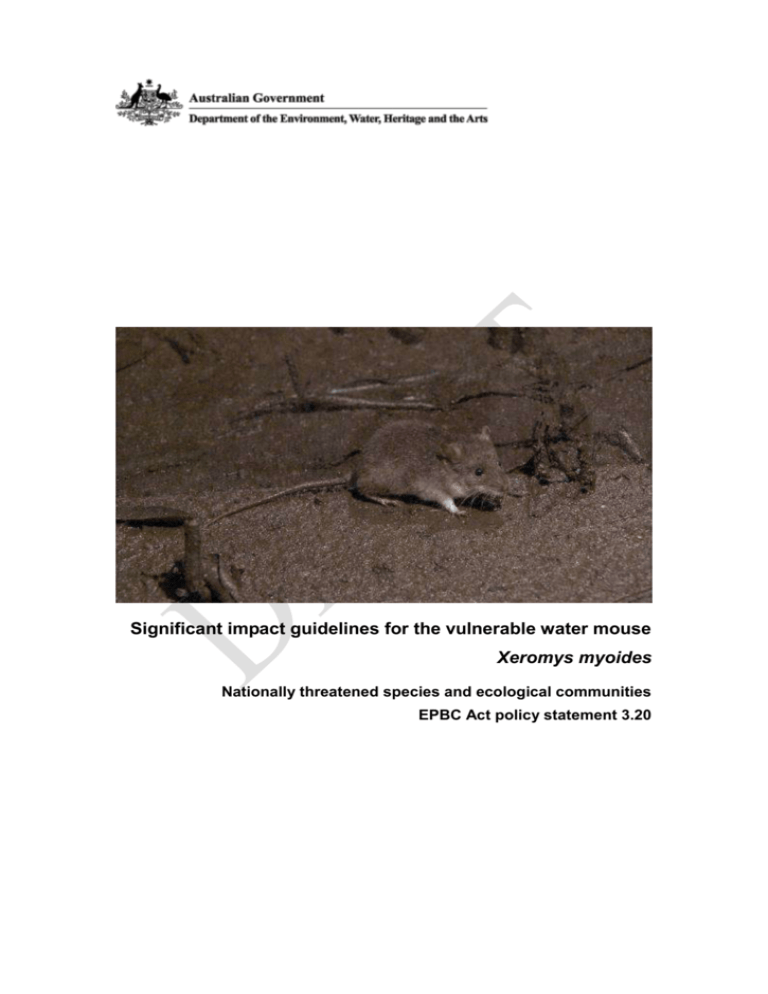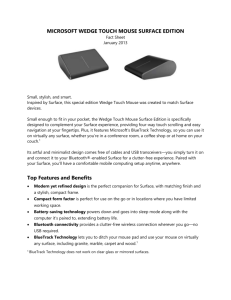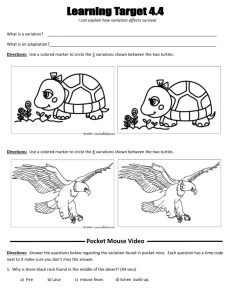
Significant impact guidelines for the vulnerable water mouse
Xeromys myoides
Nationally threatened species and ecological communities
EPBC Act policy statement 3.20
© Commonwealth of Australia 2009
This work is copyright. You may download, display, print and reproduce this material in
unaltered form only (retaining this notice) for your personal, non-commercial use or use within
your organisation. Apart from any use as permitted under the Copyright Act 1968, all other
rights are reserved. Requests and inquiries concerning reproduction and rights should be
addressed to Commonwealth Copyright Administration, Attorney General’s Department,
Robert Garran Offices, National Circuit, Barton ACT 2600 or posted at www.ag.gov.au/cca.
Disclaimer
The contents of this document have been compiled using a range of source materials and is
valid as at November 2009. The Australian Government is not liable for any loss or damage
that may be occasioned directly or indirectly through the use of reliance on the contents of the
document.
Front page photograph: The water mouse Xeromys myoides (photo taken by Totally Wild,
Channel Ten)
EPBC Act Policy Statement 3.20 – Significant Impact Guidelines for the vulnerable water mouse Xeromys myoides
2
1. Introduction
The water mouse Xeromys myoides is listed as vulnerable under the
Australian Government Environment Protection and Biodiversity Conservation
Act 1999 (EPBC Act). Listed threatened species and ecological communities
are a matter of national environmental significance. Under the EPBC Act an
action will require approval from the federal environment minister if the action
has, will have, or is likely to have a ‘significant impact’ on a matter of national
environmental significance.
A ‘significant impact’ is an impact which is important, notable, or of
consequence, having regard to its context or intensity. Whether or
not an action is likely to have a significant impact depends upon
the sensitivity, value, and quality of the environment which is
impacted, and upon the intensity, duration, magnitude and
geographic extent of the impacts. You should consider all of these
factors when determining whether an action is likely to have a
significant impact on matters of national environmental
significance.
This policy statement is designed to help determine whether a proposed
action may have a significant impact on the water mouse. The policy
statement applies to mangrove communities and associated saltmarsh,
sedgelands, clay pans, floodplains, heathlands and coastal freshwater
wetlands within the known and potential range of the water mouse in south
east Queensland, central south Queensland and Northern Territory (see
Figure 1).
This policy statement is based on the best available information, including:
scientific literature
consultation with species experts, and
application of the national environmental legislation (EPBC Act).
This policy statement builds on the information and explanations in EPBC Act
policy statement 1.1 Significant impact guidelines – Matters of national
environmental significance.
EPBC Act Policy Statement 3.20 – Significant Impact Guidelines for the vulnerable water mouse Xeromys myoides
3
Figure 1
Habitat mapping for the water mouse
EPBC Act Policy Statement 3.20 – Significant Impact Guidelines for the vulnerable water mouse Xeromys myoides
4
2. How to interpret and apply these guidelines
The significance thresholds outlined in this policy statement are not designed
to be prescriptive, but rather to clarify the level and types of impact likely to be
significant at a national level, having regard for the biology and ecology of and
threats to the species. If you are planning an action in any areas in Figure 1
you should consider the following:
Does my site support the water mouse (see section 4 & 6)?
What impacts, both direct and indirect, could result from my action (see
section 5)?
Could any of these impacts exceed the significance thresholds (see
section 7)?
What measures could be taken to reduce the level of impact (see
section 9)?
If you think that your action may have a significant impact on a matter of
national environmental significance, or if you are unsure, you should refer the
action to the federal environment minister. The minister will make a decision
within 20 business days on whether approval is required under the EPBC Act.
Substantial penalties apply for taking an action that has, will have or is likely
to have a significant impact without approval.
3. What other laws protect the water mouse?
The water mouse is listed as vulnerable under the EPBC Act. Listed
threatened species and ecological communities are a matter of national
protected matter that recognises the importance from a national perspective.
Under the EPBC Act an action will require approval from the federal
environment minister if the action has, will have, or is likely to have a
significant impact on a matter of national environmental significance..
The water mouse is also listed as ‘vulnerable’ in Queensland under the
Queensland Nature Conservation Act 1992 and as ‘data deficient’ in the
Northern Territory under the Territory Parks and Wildlife Conservation Act
2000. The listing of a species, subspecies or ecological community listed as
threatened under the EPBC Act recognises the conservation status of the
entity from a National perspective and does not replace listing under
state/territory, regional or local legislation or regulations.
Judgements may differ between Australian, state and local decision-making
processes, due to the different scales of consideration. If your activity could
affect the species or individual animals you should contact the relevant
state/territory and local authorities to find out your obligations.
4. Ecology of the water mouse
Description of the species
The water mouse is a small rodent which has a maximum head and body
length of 126mm and maximum weight of 64g. It has short, very dense and
silky fur that is dark slate-grey above and pure white below. The species has
a strong musty odour. Very old individuals are grizzled all over and have a
rufous wash to the flanks. Adults are usually white-spotted dorsally
EPBC Act Policy Statement 3.20 – Significant Impact Guidelines for the vulnerable water mouse Xeromys myoides
5
(Queensland). The ears are rounded and short and the eyes are very small.
The hindfeet are not webbed. The tail is slender, thinly haired and very finely
ringed (smooth). The water mouse has only two molars in each of the upper
and lower rows. The water mouse appears to be totally nocturnal.
Distribution
The water mouse occurs in three discrete populations on the eastern and
northern Australian coastline. In south-east Queensland the water mouse
occurs between the Coomera River (50km southeast of Brisbane) and Hervey
Bay; the islands of Moreton Bay and Pumicestone Passage, including the lee
of north and south Stradbroke and Bribie Islands; and Fraser Island. In central
south Queensland the water mouse occurs between Agnes Water and
Cannonvale and in the Northern Territory it has been recorded between the
Glyde River in eastern Arnhem Land and the Daly River floodplain.
Habitat
The water mouse requires mangrove communities and associated saltmarsh,
sedgelands, clay pans, heathlands and freshwater wetlands with intact
hydrology that provide adequate nest sites and prey resources. Where
present, it may also use a supralittoral zone (with or without a supralittoral
bank) for the construction of nest mounds. Water mouse habitat varies across
the three disjunct populations (refer to the background paper).
Nesting
The water mouse creates nests which are important for breeding and refuge
from high tides and predators. The water mouse constructs five types of
nests: free-standing mound nests or mounds at the base of mangrove trees,
mound nests on small elevated ‘islands’ within the tidal zone, mound nests or
holes in supralittoral banks; nests inside hollow tree trunks, and nests in spoil
heaps created as a result of human activity. It is assumed the species does
not need to build mounds or obvious nest structures in non-tidal
environments.
Reproductive biology
Little is known about the reproductive biology of the water mouse. Research
undertaken on North Stradbroke Island found that up to eight individuals of
both sexes can share a nest mound, however, there was generally only one
sexually active male present. The nest may also be used by successive
generations over a number of years. It is possible that the water mouse is
capable of breeding throughout the year.
Movements
The water mouse generally exhibits frenetic activity; travelling relatively large
distances of up to 2.9km a night while criss-crossing home ranges averaging
0.7ha. In south-east Queensland the water mouse has been observed
following the receding tide out through sedgelands and into the mangroves
where it foraged at night over a home range estimated at approximately 0.8ha
for males and 0.6ha for females. There is no available information about
dispersal movements in this species.
Further detail on the ecology of the water mouse including habitat suitability
mapping is provided in the background paper.
EPBC Act Policy Statement 3.20 – Significant Impact Guidelines for the vulnerable water mouse Xeromys myoides
6
5. Principal threats to the water mouse
Principal threats most relevant to judgements on significance of impacts to the
water mouse include:
habitat removal as a result of development actions for example
vegetation clearing to extract minerals
habitat degradation as a result of development actions:
alteration of natural hydrology for example increased freshwater
inflows to mangroves and acidic heathlands, or increased
sedimentation from storm-water runoff
fragmentation e.g. through powerlines and water pipeline
easements
acid sulphate exposure
oil pollution
introduction of weeds e.g. mimosa in the Northern Territory
habitat degradation and disturbance from recreational activities:
vehicle damage in supralittoral habitat
prolonged or intensive wave action from recreational vessels (for
example jet skis, motorboats) eroding or washing away mound
nests and damaging banks
chemical control of insects and weeds for example mosquitocides and
herbicides.
fire in the supralittoral zone (resulting from development actions,
natural, recreational or arson)
feral predators (increased risk from habitat fragmentation and urban
encroachment, namely cats as habitat fragmentation may provide them
with easier access to water mouse habitat), and
grazing by cattle for example trampling or denudation of intertidal
habitats.
6. Survey guidelines for the water mouse
A guide to conducting surveys for the water mouse is outlined below. Surveys
should:
be conducted by a suitably qualified person with experience in mammal
surveys
maximise the chance of detecting the species
determine the context of the site within the broader landscape, and
account for uncertainty and error.
EPBC Act Policy Statement 3.20 – Significant Impact Guidelines for the vulnerable water mouse Xeromys myoides
7
Consideration should be given to the timing, effort,
methods and area to be covered in the context of
the proposed action. If surveys are conducted
outside recommended periods or conditions,
survey methods and effort should be adjusted to
compensate for the decreased likelihood of
detecting the species.
Survey recommendations
Best practice surveys for the water mouse include implementation of all
primary survey techniques either with or without the use of supplementary
survey techniques.
Primary survey techniques
Habitat assessment, daytime searches and Elliott trapping are the three most
reliable methods for detecting the presence of the water mouse. Surveyors
should examine aerial photos and topographical maps before commencing a
habitat assessment or trapping program. This will target and identify elevated,
dry supralittoral areas within mangrove communities which may support active
nest mounds.
Habitat assessment
A habitat assessment should record all notable habitat features in the study
area including vegetation types and species, presence of prey species and
prey middens, trees with hollow trunks etc.
Daytime searching
Daytime searches should include transect style searches spaced at 50-100m
intervals, or in quadrats, and involve one to two hours spent looking for
nesting structures for every one hectare of intertidal or supralittoral water
mouse habitat.
Elliott trapping
Elliott trapping (Size A) must be carried out at night. Elliott trapping is the only
reliable method for estimating water mouse population density. Elliott traps
should be baited with pilchards cut in half, mullet pieces or commercial cat
food. The minimum survey effort required to trap the water mouse is 400 trap
nights per four to five hectares of potential water mouse habitat.
EPBC Act Policy Statement 3.20 – Significant Impact Guidelines for the vulnerable water mouse Xeromys myoides
8
Supplementary survey techniques
Pitfall trapping, spotlighting and hair tubing can be used to increase the
probability of detecting the water mouse. However these techniques are not
required where primary techniques are implemented.
Please refer to the background paper for additional details for example
primary and secondary survey guidelines, including trap effort, and regional
considerations for the various survey techniques.
7. What sorts of actions are likely to have a significant impact on the
species?
Significant impact judgements must be made on a case-by-case basis and
with consideration for the context of the action. The potential for a significant
impact on a listed threatened species will depend on:
the intensity, duration, magnitude and geographic extent of the impact
the sensitivity, value and quality of the environment on and around the
site
the cumulative effect of on-site, off-site, direct and indirect impacts, and
the presence of this and other matters of national environmental
significance.
Development actions that may impact on the water mouse include sand
mining, urban residential development, resorts and marina development, bund
walling, aquaculture projects and creation or upgrade of easements for energy
distribution for example electricity, gas or water pipelines.
Significant impact threshold
There is a possibility of a significant impact on the water mouse if the action
impacts breeding of an important population and/or reduces dispersal across
habitat patches, or removes habitat critical to the survival of the species.
Important populations
A water mouse population is regarded as an ‘important population’ if it:
shows evidence of recent activity for example nest mounds, plastering,
middens
occurs in habitat critical to the survival of the species
occurs in a protected area for example Great Sandy National Park
occurs at or near the limits of the range of one of the regional
populations (see Figure 1)
occurs at or near the limits of the species’ range (see Figure 1)
has been the subject of long-term monitoring, or
preserves high genetic diversity for the species.
Specific regional considerations for determining an important population are
listed in the background paper.
EPBC Act Policy Statement 3.20 – Significant Impact Guidelines for the vulnerable water mouse Xeromys myoides
9
Habitat critical to the survival of the species
Habitat critical to the survival of the species includes mangrove communities
and other intertidal communities or coastal freshwater wetlands with intact
hydrology, prey resources, nest mounds and/or natural features such as a
supralittoral bank to enable the construction of nests..
8. What does this mean for actions in water mouse habitat?
If you plan an action that may have a significant impact then you should refer
the proposal to the minister before commencing the action. The minister will
decide, within 20 business days, whether assessment and approval is
required under the EPBC Act. More information on referral and assessment is
available at www.environment.gov.au/epbc/assessments/process.html.
9. How can my action avoid having a significant impact on the water
mouse?
Mitigation are all measures taken on the site of the action, to avoid or reduce
impacts. Measures should be incorporated into the design of the action at the
conceptual and planning stage(s) to:
reduce the level of the impact to below the significant impact threshold
outlined in this policy statement
monitor the performance of the mitigation measures (specify the
timeframe for example by using performance indicators measured at
seasonally/annually nominated times), and
feedback into an adaptive management plan, to quickly react to any
changes in performance.
Mitigation and management actions must:
prioritise impact avoidance over impact reduction measures
avoid negative impacts on other matters of national environmental
significance, and
be consistent with relevant recovery, conservation and action plans.
The following measures may assist in avoiding impacts on the water mouse:
retain habitat known or likely to contain water mouse, and manage for
the species
maintain existing hydrology (including any appropriate flood regime, as
well as water flow and quality)
avoid habitat fragmentation
retain supralittoral and intertidal habitat corridors
maintain current site conditions (for example disturbance regimes,
stock grazing, etc) until impacts or benefits of disturbance are
evaluated.
If impacts are unavoidable they can be minimised by:
establishing a buffer of natural vegetation of at least 30 m around areas
identified as containing or linking likely water mouse habitat
EPBC Act Policy Statement 3.20 – Significant Impact Guidelines for the vulnerable water mouse Xeromys myoides
10
actively monitoring water mouse populations and using results to
update management actions
capturing and reducing fresh water run-off (for example by recycling)
that may reduce salinity and affect water mouse habitat and prey
abundance
erecting fencing to exclude livestock such as cattle, horses, feral pigs,
dogs, foxes, and cats
appropriately managing and treating noxious weeds for example
groundsel.
Further information on managing impacts and experimental mitigation
measures can be found in the background paper.
10. Translocation
Translocation does not reduce the impact of an action. Translocation of the
water mouse is not considered to mitigate or offset the impact of an action,
since any translocation, no matter how successful, cannot lessen the loss of
habitat.
11. Where can I get more information?
The background paper for this policy statement provides a biological and
ecological context for survey guidelines, significant impact thresholds, and
mitigation measures.
Other EPBC Act policy statements are available to help you to understand the
EPBC Act and your obligations. They are available from the department’s
website at: www.environment.gov.au/epbc/guidelines-policies.html, or by
contacting the community information unit by email: ciu@environment.gov.au
or by phone: 1800 803 772.
The Protected Matters Search Tool can provide a good starting point for
determining the likelihood of having matters of national environmental
significance in your area. State and territory government agencies may also
hold relevant information including habitat and species distribution
information.
Further information on this and other listed threatened species and ecological
communities is at the department’s species profiles and threats database
(SPRAT) at: www.environment.gov.au/cgi-bin/sprat/public/sprat.pl.
EPBC Act Policy Statement 3.20 – Significant Impact Guidelines for the vulnerable water mouse Xeromys myoides
11






